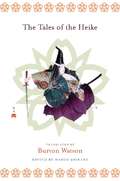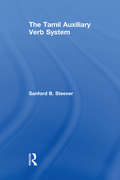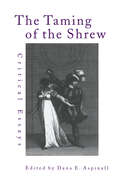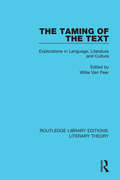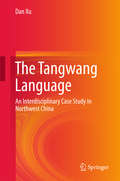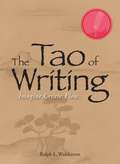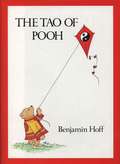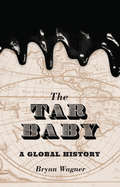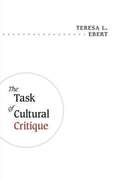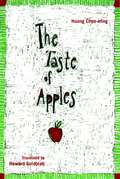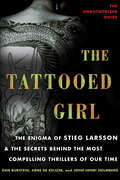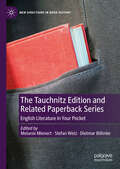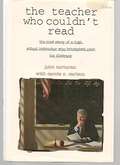- Table View
- List View
The Tales of the Heike (Translations from the Asian Classics)
by Burton Watson Haruo ShiraneThe Tales of the Heike is one of the most influential works in Japanese literature and culture, remaining even today a crucial source for fiction, drama, and popular media. Originally written in the mid-thirteenth century, it features a cast of vivid characters and chronicles the epic Genpei war, a civil conflict that marked the end of the power of the Heike and changed the course of Japanese history. The Tales of the Heike focuses on the lives of both the samurai warriors who fought for two powerful twelfth-century Japanese clans-the Heike (Taira) and the Genji (Minamoto)-and the women with whom they were intimately connected.The Tales of the Heike provides a dramatic window onto the emerging world of the medieval samurai and recounts in absorbing detail the chaos of the battlefield, the intrigue of the imperial court, and the gradual loss of a courtly tradition. The book is also highly religious and Buddhist in its orientation, taking up such issues as impermanence, karmic retribution, attachment, and renunciation, which dominated the Japanese imagination in the medieval period.In this new, abridged translation, Burton Watson offers a gripping rendering of the work's most memorable episodes. Particular to this translation are the introduction by Haruo Shirane, the woodblock illustrations, a glossary of characters, and an extended bibliography.
The Talk of the Clinic: Explorations in the Analysis of Medical and therapeutic Discourse (Routledge Communication Series)
by G. H. MorrisThis collection of original papers by scholars who closely analyze the talk of the clinic features studies that were conceived with the aim of contributing to clinical practitioners' insight about how their talk works. No previous communication text has attempted to take such a practitioner-sensitive posture with its research presentations. Each chapter focuses on one or more performances that clinical practitioners -- in consort with their clients or colleagues -- must achieve with some regularity. These speech acts are consequential for effective practice and sometimes present themselves as problematic. Rather than calling for research to be simplified or reoriented in order for practitioners to understand it, these authors interpret state-of-the-art descriptive analysis for its practical import for clinicians. Each contributor delves deeply into clinical practice and its wisdom; therefore, each is positioned to identify alternative clinical practices and techniques and to appreciate practitioners' means of performing effectively. When reflective practitioners encounter these new pieces of work, productive alterations in how their work is done can be stimulated. By reading this work, reflective practitioners will now have new ways of considering their talk and new possibilities for speaking effectively. The volume is uniquely constructed so as to engage in dialogue with these reflective practitioners as they struggle to articulate their work. A practical wisdom-as-research trend has recently emerged in the clinical fields stimulating these practitioners to explore new and more informative ways -- communication and literary theory, ethnography, and discourse analysis -- to express what they do in clinics and hospitals. With the studies presented in this book, the editors build upon this dialectical process between practitioner and researcher, thus helping this productive conversation to continue.
The Tamil Auxiliary Verb System (Routledge Studies in Asian Linguistics)
by Sanford B. SteeverThis book introduces the syntactic process of auxiliary formation and applies it to the grammatical analysis of the indicative, or non-modal, auxiliary verbs of Modern Tamil. Using data from spoken and written registers gathered over several years, the book demonstrates for the first time the systematic nature of auxiliary verb phenomena, and how they are integrated into the grammar of the language. Including fresh information on new verb constructions, verbal categories and tenses, this book will be a welcome addition to the current general linguistics literature, in particular the study of verbal categories and the morphosyntactic processes that instantiate them.
The Taming of the Shrew (SparkNotes Literature Guide Series)
by SparkNotesThe Taming of the Shrew (SparkNotes Literature Guide) by William Shakespeare Making the reading experience fun! Created by Harvard students for students everywhere, SparkNotes is a new breed of study guide: smarter, better, faster. Geared to what today's students need to know, SparkNotes provides: *Chapter-by-chapter analysis *Explanations of key themes, motifs, and symbols *A review quiz and essay topicsLively and accessible, these guides are perfect for late-night studying and writing papers
The Taming of the Shrew: Critical Essays (Shakespeare Criticism)
by Dana E. AspinallThis volume is a comprehensive collection of critical essays on The Taming of the Shrew, and includes extensive discussions of the play's various printed versions and its theatrical productions. Aspinall has included only those essays that offer the most influential and controversial arguments surrounding the play. The issues discussed include gender, authority, female autonomy and unruliness, courtship and marriage, language and speech, and performance and theatricality.
The Taming of the Text: Explorations in Language, Literature and Culture (Routledge Library Editions: Literary Theory #19)
by Willie Van PeerThe contributors of this text, first published in 1988, provide a dynamic view of the social functioning of texts, taking account of linguistic, literary and cultural elements. They bring together innovative perspectives on literary analysis and theory, on pragmatics and discourse analysis, as well as on text linguistics and reception theory. Various text types are examined, and the editor introduces each chapter in order to draw them all together to make a fascinating and cohesive whole.
The Taming of the Text: Explorations in Language, Literature and Culture (Routledge Library Editions: Literary Theory)
by Willie Van PeerThe contributors of this text, first published in 1988, provide a dynamic view of the social functioning of texts, taking account of linguistic, literary and cultural elements. They bring together innovative perspectives on literary analysis and theory, on pragmatics and discourse analysis, as well as on text linguistics and reception theory. Various text types are examined, and the editor introduces each chapter in order to draw them all together to make a fascinating and cohesive whole.
The Tangwang Language
by Dan XuThis book studies the Tangwang language, providing the first comprehensive grammar in English of this Chinese variety, with detailed analysis of its phonology, morphology, and syntax. This fills a gap in the literature, as previously only a few articles on this language were available. The book takes an interdisciplinary approach, examining genetic data to determine historical patterns of population migration, as well as linguistic data that focus on the influence of the Dongxiang (Santa) language as a consequence of language contact on the Silk Road. The concluding chapter argues that Tangwang has not yet become a mixed language, and that syntactic borrowing has a stronger impact than lexical borrowing on languages.
The Tao Of Writing
by Ralph L. WahlstromThe creative process doesn't have to be torturous--with The Tao of Writing, it can be glorious! Invoking the principles of the Tao allows you to do your best work ever. By tapping into the true flow of your creativity, you can discover and develop your true talents and abilities. Author Ralph Wahlstrom uses the connection between teaching, writing, and the tenets of the Tao to help you learn to write from a new perspective, enhancing your work and your creative journey. With The Tao of Writing as your guide, you can overcome "writer's rigor mortis," and become a better, happier, more productive writer.
The Tao Of Writing: Imagine. Create. Flow.
by Ralph L WahlstromA Simon & Schuster eBook. Simon & Schuster has a great book for every reader.
The Tao and the Logos: Literary Hermeneutics, East and West
by Longxi ZhangQuestions of the nature of understanding and interpretation--hermeneutics--are fundamental in human life, though historically Westerners have tended to consider these questions within a purely Western context. In this comparative study, Zhang Longxi investigates the metaphorical nature of poetic language, highlighting the central figures of reality and meaning in both Eastern and Western thought: the Tao and the Logos. The author develops a powerful cross-cultural and interdisciplinary hermeneutic analysis that relates individual works of literature not only to their respective cultures, but to a combined worldview where East meets West. Zhang's book brings together philosophy and literature, theory and practical criticism, the Western and the non-Western in defining common ground on which East and West may come to a mutual understanding. He provides commentary on the rich traditions of poetry and poetics in ancient China; equally illuminating are Zhang's astute analyses of Western poets such as Rilke, Shakespeare, and Mallarmé and his critical engagement with the work of Foucault, Derrida, and de Man, among others. Wide-ranging and learned, this definitive work in East-West comparative poetics and the hermeneutic tradition will be of interest to specialists in comparative literature, philosophy, literary theory, poetry and poetics, and Chinese literature and history.
The Tao of Pooh
by Benjamin HoffThe how of Pooh? The Tao of who? The Tao of Pooh!?! In which it is revealed that one of the world's great Taoist masters isn't Chinese--or a venerable philosopher--but is in fact none other that that effortlessly calm, still, reflective bear. A. A. Milne's Winnie-the-Pooh!While Eeyore frets, and Piglet hesitates, and Rabbit calculates, and Owl pontificates, Pooh just is.<P> And that's a clue to the secret wisdom of the Taoists.
The Tao of Writing: Imagine, Create, Flow
by Ralph L. Wahlstrom.The creative process doesn't have to be torturous-with The Tao of Writing, it can be glorious! Invoking the principles of the Tao allows writers do their best work ever. By tapping into the true flow of their creativity, writers can discover and develop their true talents and abilities. Author Ralph L. Wahlstrom uses the connection between teaching, writing, and the tenets of the Tao to help writers hone their craft from a new perspective, enhancing their work and their creative journey. Organized into three parts, this engaging book is as practical as it is inspiring: The Philosophy-Why the Tao in Writing?: A brief introduction to Taoist thought, drawing from the tao te ching, Chuang tze, the Tao of Pooh, and well-known writers The Twelve Principles of Tao in Writing: Exploring the twelve principles of the Tao in relation to writing Applying the Tao to Writing: More than 100 writing exercises that help set writers in motion and build their momentum to create original, well-realized works With The Tao of Writing as their guide, readers can overcome "writer's rigor mortis," and become better, happier, more productive writers.
The Tar Baby: A Global History
by Bryan WagnerA richly nuanced cultural history of an enigmatic and controversial folktalePerhaps the best-known version of the tar baby story was published in 1880 by Joel Chandler Harris in Uncle Remus: His Songs and His Sayings, and popularized in Song of the South, the 1946 Disney movie. Other versions of the story, however, have surfaced in many other places throughout the world, including Nigeria, Brazil, Corsica, Jamaica, India, and the Philippines. The Tar Baby offers a fresh analysis of this deceptively simple story about a fox, a rabbit, and a doll made of tar and turpentine, tracing its history and its connections to slavery, colonialism, and global trade.Bryan Wagner explores how the tar baby story, thought to have originated in Africa, came to exist in hundreds of forms on five continents. Examining its variation, reception, and dispersal over time, he argues that the story is best understood not merely as a folktale but as a collective work in political philosophy. Circulating at the same time and in the same places as new ideas about property and politics developed in colonial law and political economy, the tar baby comes to embody an understanding of the interlocking processes by which custom was criminalized, slaves were captured, and labor was bought and sold.Compellingly argued and ambitious in scope, the book concludes with twelve versions of the story transcribed from various cultures in the late nineteenth and early twentieth centuries.
The Targeting System of Language (The\mit Press Ser.)
by Leonard TalmyA proposal that a single linguistic/cognitive system, “targeting,” underlies two domains of reference, anaphora (speech-internal) and deixis (speech-external).In this book, Leonard Talmy proposes that a single linguistic/cognitive system, targeting, underlies two domains of linguistic reference, those termed anaphora (for a referent that is an element of the current discourse) and deixis (for a referent outside the discourse and in the spatiotemporal surroundings). Talmy argues that language engages the same cognitive system to single out referents whether they are speech-internal or speech-external.Talmy explains the targeting system in this way: as a speaker communicates with a hearer, her attention is on an object to which she wishes to refer; this is her target. To get the hearer's attention on it as well, she uses a trigger—a word such as this, that, here, there, or now. The trigger initiates a three-stage process in the hearer: he seeks cues of ten distinct categories; uses these cues to determine the target; and then maps the concept of the target gleaned from the cues back onto the trigger to integrate it into the speaker's sentence, achieving comprehension. The whole interaction, Talmy explains, rests on a coordination of the speaker's and hearer's cognitive processing. The process is the same whether the referent is anaphoric or deictic.Talmy presents and analyzes the ten categories of cues, and examines sequences in targeting, including the steps by which interaction leads to joint attention. A glossary defines the new terms in the argument.
The Task of Cultural Critique
by Teresa L. Ebert"A stimulating, path-breaking text that stands out as both an anti-text in the arena of cultural studies and as a classic Marxist analysis of the field of cultural critique." --Peter McLaren, author of Che Guevara, Paulo Freire, and the Pedagogy of Revolution "This powerful book confirms that Teresa L. Ebert is one of the most significant Marxist theorists currently writing about the humanities." --Barbara Foley, author of Spectres of 1919: Class and Nation in the Making of the New Negro In this study, Teresa L. Ebert makes a spirited, pioneering case for a new cultural critique committed to the struggles for human freedom and global equality. Demonstrating the implosion of the linguistic turn that isolates culture from historical processes, The Task of Cultural Critique maps the contours of an emerging materialist critique that contributes toward a critical social and cultural consciousness. Through groundbreaking analyses of cultural texts, Ebert questions the contemporary Derridan dogma that asserts "the future belongs to ghosts." Events-to-come are not spectral, she contends, but the material outcome of global class struggles. Not "hauntology" but history produces cultural practices and their conflitive representations--from sexuality, war, and consumption to democracy, torture, globalization, and absolute otherness. With close readings of texts from Proust and Balzac to "Chick Lit," from Lukács, de Man, Deleuze, and Marx to Derrida, Žižek, Butler, Kollontai, and Agamben, the book opens up new directions for cultural critique today.
The Task of the Cleric: Cartography, Translation, and Economics in Thirteenth-Century Iberia
by Simone PinetComposed in early thirteenth-century Iberia, the Libro de Alexandre was Spain's first vernacular version of the Romance of Alexander and the first poem in the corpus now known as the mester de clerecía. These learned works, written by clergy and connected with both school and court, were also tools for the articulation of sovereignty in an era of prolonged military and political expansion.In The Task of the Cleric, Simone Pinet considers the composition of the Libro de Alexandre in the context of cartography, political economy, and translation. Her discussion sheds light on how clerics perceived themselves and on the connections between literature and these other activities. Drawing on an extensive collection of early cartographic materials, much of it rarely considered in conjunction with the romance, Pinet offers an original and insightful view of the mester de clerecía and the changing role of knowledge and the clergy in thirteenth-century Iberia.
The Taste of Apples (Modern Chinese Literature from Taiwan)
by Huang Huang Chun-mingFrom the preeminent writer of Taiwanese nativist fiction and the leading translator of Chinese literature come these poignant accounts of everyday life in rural and small-town Taiwan. Huang is frequently cited as one of the most original and gifted storytellers in the Chinese language, and these selections reveal his genius. In "The Two Sign Painters," TV reporters ambush two young workers from the country taking a break atop a twenty-four-story building. "His Son's Big Doll" introduces the tortured soul inside a walking advertisement, and in "Xiaoqi's Cap" a dissatisfied pressure-cooker salesman is fascinated by a young schoolgirl.Huang's characters—generally the uneducated and disadvantaged who must cope with assaults on their traditionalism, hostility from their urban brethren and, of course, the debilitating effects of poverty—come to life in all their human uniqueness, free from idealization.
The Tattooed Girl: The Enigma of Stieg Larsson & the Secrets Behind the Most Compelling Thrillers of Our Time
by Dan Burstein Arne De Keijzer John-Henri HolmbergThe fascinating stories behind what have been rightly called the "hottest books on the planet": The Girl with the Dragon Tattoo, The Girl Who Played with Fire, and The Girl Who Kicked the Hornet's NestThrough insightful commentary and revealing interviews, you will enter the unique world of Lisbeth Salander, Mikael Blomkvist---and of Stieg Larsson himself---discovering the fascinating real-life experiences and incidents involving Swedish politics, violence against women, and neo-Nazis that are at the heart of Larsson's work.John-Henri Holmberg, a Swedish author and close friend of Larsson for more than three decades, provides a unique insider's look into the secrets of the author's imaginative universe, his life, and his ideas for future books---including the mysterious "fourth book" in the series, which Larsson had started but not finished at the time of his death.Included within are answers to compelling questions on every Larsson fan's mind: · What makes the Lisbeth Salander character so unique and memorable? Why have so many people from all backgrounds and with all kinds of tastes found The Girl with the Dragon Tattoo so riveting?· What are the speculations---and what is the truth---about Stieg Larsson's tragic death at age fifty, just before the publication of his novels, and the bitter battle over his legacy?· What changes were made in the plots and translations of the novels after Larsson's death---and why?· How did Larsson's early interest in science fiction and American and British crime writers feed into his creation of the Millennium trilogy? · What were Larsson's ideas for the fourth book, and are there any clues to the plots he imagined for his ten-book series? Will we meet Lisbeth's twin sister, Camilla, or any of her other seven siblings that Zalachenko tells her she has? · Does Lisbeth Salander give feminism a new definition? · What will happen in the contentious battle between Stieg Larsson's life partner, Eva Gabrielsson, and his father and brother over the future of the books, as well as the billion dollars at stake in his legacy?· Who are the emerging Swedish crime writers we should pay attention to now?· And much, much more!
The Tauchnitz Edition and Related Paperback Series: English Literature in Your Pocket (New Directions in Book History)
by Melanie Mienert Stefan Welz Dietmar BöhnkeThe Tauchnitz Edition and Related Paperback Series: English Literature in Your Pocket unites a broad variety of interests and different perspectives concerning the legacy of the Tauchnitz Edition in particular and English language paperback series in general. It provides an international and interdisciplinary approach to the 'paperback revolution' as part of media culture throughout the 19th and 20th centuries. The Bernhard Tauchnitz' Collection of British and American Authors, initiated in 1841, was not only a successful entrepreneurial endeavor but a milestone in the history of print culture as well. The Leipzig-based Tauchnitz publishers, renowned all over the world for their series of affordable pocket books in English, produced more than 5000 volumes within the course of over 100 years. Cultural and literary repercussions of this unique achievement have been far-reaching since the late 19th century. It pioneered a new way of mass-market publishing, innovative copyright arrangements and a close cooperation with many important English-language novelists of the day. Still in present times, the Tauchnitz Edition and its successors are stimulating both academic research in various fields and the enthusiasm of collectors and readers.
The Teach Like a Champion Guide to the Science of Reading: Translating Research to Reignite Joy and Meaning in the Classroom
by Doug Lemov Erica Woolway Colleen DriggsThe most comprehensive and practical guide to understanding and applying the science of reading to improve literacy instruction. After effectively teaching phonics in the early grades, what does the science of reading tell us should happen in literacy classes? The Teach Like a Champion Guide to the Science of Reading by Doug Lemov, Erica Woolway, and Colleen Driggs, addresses the pressing challenges educators face in effectively incorporating the Science of Reading into their instruction once students already know how to decode. By offering actionable guidance grounded in seven evidence-based principles, this book helps teachers elevate their instructional practices and better prepare students to be lifelong readers and thinkers. Grounded in proven classroom instruction, the book focuses on techniques that can allow teachers to use the science as effectively and actionably as possible. The Teach Like a Champion Guide to the Science of Reading is enhanced with more than 50 video clips from the classroom and covers ways to practically apply the Science of Reading. The book describes the often overlooked role of fluency in reading comprehension, even into the high school years; the profound importance of managing and socializing attention in an age of technology; the central role of background knowledge in understanding text; and the doubly important role of teaching vocabulary as a form of knowledge. It adds a discussion of how writing can make students better readers and how important it is that reading classes focus on reading actual books—great ones, ideally. And it closes with a discussion of close reading and the challenge of preparing students to rise to the challenge of complex text. Inside the book: An innovative approach to building and reinforcing background knowledge in reading Over 50 video demonstrations of effective teaching techniques Sample lesson plans and materials for immediate classroom application The Teach Like a Champion Guide to the Science of Reading is essential for educators, literacy coaches, and administrators who aim to foster rigorous literacy instruction in their classrooms and schools. This guide shows you how to implement techniques that ensure students find joy in reading and become better, wiser, more engaged and more motivated readers, both in their classrooms and in their lives beyond.
The Teacher Clarity Playbook, Grades K-12: A Hands-On Guide to Creating Learning Intentions and Success Criteria for Organized, Effective Instruction
by Douglas Fisher Nancy Frey John T. Almarode Joseph Assof Olivia Amador Kierstan BarbeeUnlock the secrets to student achievement with purposeful learning and clear expectations On a clear day, you can learn forever— that’s the adapted lyric you’ll be happily humming once you’ve covered this playbook, because you will have mastered using learning intentions and success criteria, the twin engines of Teacher Clarity. This template-filled guide shows you how to own it, do it, and live it—and your students will be more successful as a result. In this fully revised edition, this succinct, smart, and swift book’s nine learning modules take you systematically through a process that begins and ends with standards. With abundant and all new examples that span grade levels, planning templates for every step, key professional learning questions, new videos, revised success criteria and relevance sections, and the latest research, you have the most practical and up-to-date planner for designing and delivering highly effective instruction: Identifying Concepts and Skills Sequencing Learning Progressions Elaborating Learning Intentions Crafting Success Criteria Modifying Learning Intentions to Include Language Expectations Determining the Relevance of the Learning Designing Assessment Opportunities Creating Meaningful Learning Experiences Establishing Mastery of Standards Designed for PLCs or independent teacher use, The Teacher Clarity Playbook helps practitioners align lessons, objectives, and outcomes of learning seamlessly, so that the classroom hours flow productively for everyone. For any teacher striving to be more organized and have stronger relationships with students, this is the book that shows you how.
The Teacher Clarity Playbook, Grades K-12: A Hands-On Guide to Creating Learning Intentions and Success Criteria for Organized, Effective Instruction
by Douglas Fisher Nancy Frey John T. Almarode Joseph Assof Olivia Amador Kierstan BarbeeUnlock the secrets to student achievement with purposeful learning and clear expectations On a clear day, you can learn forever— that’s the adapted lyric you’ll be happily humming once you’ve covered this playbook, because you will have mastered using learning intentions and success criteria, the twin engines of Teacher Clarity. This template-filled guide shows you how to own it, do it, and live it—and your students will be more successful as a result. In this fully revised edition, this succinct, smart, and swift book’s nine learning modules take you systematically through a process that begins and ends with standards. With abundant and all new examples that span grade levels, planning templates for every step, key professional learning questions, new videos, revised success criteria and relevance sections, and the latest research, you have the most practical and up-to-date planner for designing and delivering highly effective instruction: Identifying Concepts and Skills Sequencing Learning Progressions Elaborating Learning Intentions Crafting Success Criteria Modifying Learning Intentions to Include Language Expectations Determining the Relevance of the Learning Designing Assessment Opportunities Creating Meaningful Learning Experiences Establishing Mastery of Standards Designed for PLCs or independent teacher use, The Teacher Clarity Playbook helps practitioners align lessons, objectives, and outcomes of learning seamlessly, so that the classroom hours flow productively for everyone. For any teacher striving to be more organized and have stronger relationships with students, this is the book that shows you how.
The Teacher Who Couldn't Read
by Carole C. Carlson John CorcoranHere is the incredible true story of a smart kid who slipped through the system and became part of it. John Corcoran graduated from high school and college and went on to become a high school teacher--but he never learned how to read. Corcoran shares his amazing experiences of using deception to survive in a world of literates, and he clearly defines what schools, teachers, churches, and parents can do to conquer the little-known but widely spread disease of our educational system: illiteracy.
